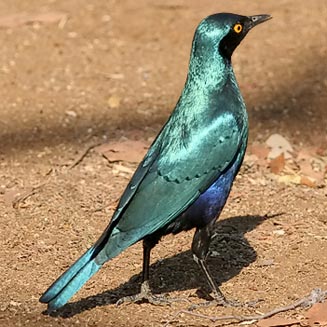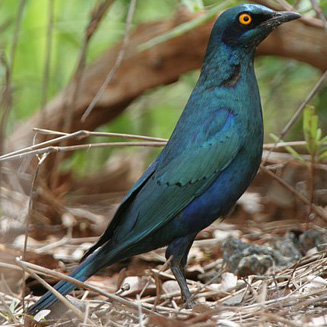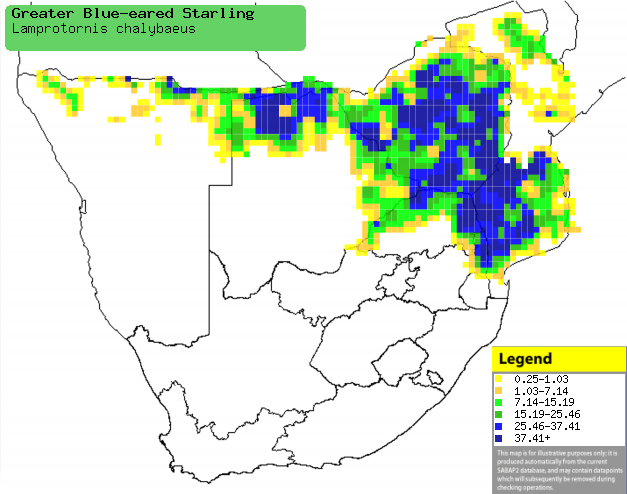|
Lamprotornis chalybaeus (Greater
Blue-eared Starling)
Groot-blouoorglansspreeu [Afrikaans];
Ndjundju (generic term for starling) [Kwangali]; Hwirigwiri (generic name for
glossy starling) [Shona]; Kwezu leri tsongo (also applied to Cape glossy
starling) [Tsonga]; Legôdi (also applied to Cape glossy starling), Leswêdi
[Tswana]; Groenstaart-glansspreeuw [Dutch]; Choucador à oreillons bleus
[French]; Grünschwanz-glanzstar [German]; Estorninho-grande-d'orelha-azul
[Portuguese]
Life
> Eukaryotes >
Opisthokonta
> Metazoa (animals) >
Bilateria >
Deuterostomia > Chordata >
Craniata > Vertebrata (vertebrates) > Gnathostomata (jawed
vertebrates) > Teleostomi (teleost fish) > Osteichthyes (bony fish) > Class:
Sarcopterygii (lobe-finned
fish) > Stegocephalia (terrestrial
vertebrates) > Tetrapoda
(four-legged vertebrates) > Reptiliomorpha > Amniota >
Reptilia (reptiles) >
Romeriida > Diapsida > Archosauromorpha > Archosauria >
Dinosauria
(dinosaurs) > Saurischia > Theropoda (bipedal predatory dinosaurs) >
Coelurosauria > Maniraptora > Aves
(birds) > Order: Passeriformes
> Family: Sturnidae >
Genus: Lamprotornis
 |
 |
|
Greater blue-eared starling, South Africa. [photo
Jeff Poklen
©] |
Greater blue-eared starling, Kruger National Park,
South Africa. [photo Trevor Hardaker ©] |
Distribution and habitat
Occurs in a band from Senegal to Ethiopia, south through
Kenya, Tanzania and Zambia to southern Africa. Here it is locally common in
Zimbabwe, Mozambique and north-eastern South Africa, extending into northern
Botswana and Namibia. It generally prefers open savanna woodland with dense
undergrowth, such as Mopane (Colosphermum mopane) and Acacia.
|
 |
|
Distribution of Greater blue-eared starling in southern Africa,
based on statistical smoothing of the records from first SA Bird Atlas
Project (©
Animal Demography unit, University of
Cape Town; smoothing by Birgit Erni and Francesca Little). Colours range
from dark blue (most common) through to yellow (least common).
See here for the latest distribution
from the SABAP2. |
Predators and parasites
It has been recorded as prey of
Falco peregrinus
(Peregrine falcon)
Brood parasites
It has been recorded as host of the
Great spotted cuckoo.
Food
It eats a variety of insects, fruit and small
invertebrates, foraging in trees and on the ground. The following food items have been recorded
in its diet:
- Animals
- insects
- frogs
- small lizards
- baby mice
- Fruit
- Ficus (figs)
- Agave (sisal)
Breeding
- The nest is built by both sexes, consisting of a simple pad of dry grass
and feathers placed in a tree cavity, either natural or an old woodpecker or
barbet hole.
- Egg-laying season is from August-January, peaking from October-November.
- It lays 2-5 eggs, which are incubated solely by the female for about
13-14 days.
- The chicks fed by both parents on a diet of insects and at a later stage
berries, leaving the nest after 23 days in one observation (recorded in
captivity).
Threats
Not threatened.
References
-
Hockey PAR, Dean WRJ and Ryan PG 2005. Roberts
- Birds of southern Africa, VIIth ed. The Trustees of the John Voelcker
Bird Book Fund, Cape Town.
|
